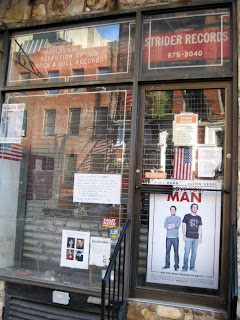 |
| B-Bap. It means rice. Sort of. |
By Mitch Broder
If I took Step 1 at Chickpea, and Step 2 at My Maki, and Step 3 at Nooi, and Step 4 at B-Bap, I could have the Hummus with Tahini and Eel in Tomato Diablo Sauce topped with Organic Bacon Bits, plus Parmesan and Green Olives, since Nooi has a Step 5.
 |
| My Maki. Before. |
But I can’t, since My Maki has just gone out of business, leaving me eelless, so for Step 2 at My Maki I’ll substitute Step 3 at B-Bap, because what could be better in Tomato Diablo Sauce than Julienned Eggs, unless it’s Bean Sprouts, which are 23 cents less?
The point here is not only that I can design a disgusting lunch. It is also that My Maki has just gone out of business. While this doesn’t delight me, it does suggest to me that people may have had their fill of places that require you to write the recipe for your food before you eat it.
The late My Maki (“Sushi How You Like it”) was one of the latest. It opened just last March, on 43rd Street between Third and Lexington. It was proud of your work. In its window it posted a quote from UrbanDaddy exclaiming that “you’ll brainstorm, micromanage, and give birth.” And where better to do those things than a sushi bar?
 |
| My Maki. After. |
In its Step 1, you chose from two Wraps. In Step 2, you chose from 10 Main Ingredients. In Step 3, you chose from 18 Other Ingredients, which included Craisins and Doritos. In Step 4, you chose from eight External Toppings, which included seven Dipping Sauces, which, perhaps for variety, were listed on the store’s menu board as Step 5.
After brainstorming and micromanaging, you could give birth to a soy-wrap eel roll with jalapeño, mango, sundried tomato, cream cheese, and Doritos, topped with crab mix and crunchy tempura, and dipped in citrus ponzu sauce. A few months after the opening I saw a guy at the corner holding up a My Maki sign. I was not surprised.
But for now, other four-step (or five-step) restaurants seem to be flourishing, no matter how much of their job they get you to do. The steps vary, sometimes at the same place, but all the spots give you the same chance to create something so vile that you’ll want to come back and try again.
 |
| Nooi. It means noodles. Sort of. |
Nooi (“Pasta-to-Go”) is on Lex between 40th and 41st. The experience here begins with the appetizing slogan “Simply pick your.” Step 1 is Size. You pick 26 or 32 ounces. Step 2 is Pasta. You pick regular or multigrain. Step 3 is Sauce; you pick from 11. Step 4 is Extras; you pick from six. Step 5 is 2 Free Toppings; you pick from another six. But at Nooi you can also pick different steps.
On its Web site, Step 1 is Step 2, and Step 2 is Step 1, and Step 4 is Customize Your Pasta, though Step 3 is still Sauce. And Step 5 is Add Salads, Drinks or Dessert, since Step 4 combines Steps 4 and 5, which doesn’t explain why only the sign in the store window refers to dessert —though not to salads and drinks — as Step 6.
Chickpea (“Always baked. Never fried.”) has several stores besides the one I visited, which is on 45th Street between Madison and Vanderbilt. Here you choose your format (pocket, wrap, platter, plate, or salad), and then you Select Your Hummus (original, basil & toasted pine nuts, roasted red pepper, jalapeño & scallions).
 |
| Chickpea. It means chickpea. |
If you’re not yet fried, you Add Your Essentials, which include Falafel, Shawarma, Shawafel, Chicken Kebab, Chicken Breast, Chickplant, Lamb Turkey Kebab, and Chicken Cutlet. Then you can choose from Extras, including eggplant, avocado, and fries, except that Extras don’t count as a step, leaving Chickpea with just three.
B-Bap (“Fusion Rice Bar”) is on Ninth Avenue between 54th and 55th. Here “customers can design their own b-bap bowl.” Step 1 is Select Your Base. Step 2 is Select Your Protein. Step 3 is Select Your Toppings. Step 4 is Select Your Sauce/Garnish. Mostly, you’re mixing rice with meat, vegetables, and sauce/garnish, making B-Bap the place with the least room for bad judgment, and the only place I know with Julienned Eggs.
 |
| 16 Handles. I assume they did the math. |
If you’ve taken steps at one of these places but still want to step out for dessert, the logical next step is 16 Handles (“Frozen Yogurt Your Way”). The chain, which has several stores in the city, invites you to Select Your Cup Size, Fill with Yogurt, Add Toppings, Weigh and Pay. It claims “trillions of possibilities.”
I don’t want trillions of possibilities. I want a cup of chocolate.
Or a bowl of rice. Or a stack of falafel. Or a plate of noodles. OK, with sauce.
I am not alone, for New York has clearly rejected cream-cheese-Dorito sushi.
Though it may have been only because the Doritos didn’t work with the teriyaki.
 |
| Getting a handle. |
























































